-
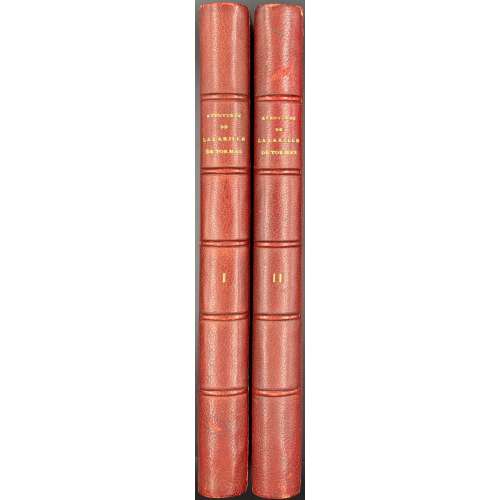 Vol. 1: Collation: 8vo; π4 1-98 104 111, (total 81 leaves), plus 22 plates, incl. frontispiece, each in two states, before and after lettering, (total 44 leaves of plates). Pagination: [i-v] vi-viii [1] 2-154, ils. Vol. 2: Collation: 8vo; π2 1-118 123, (total 93 leaves), plus 18 plates, each in two states, before and after lettering, (total 36 leaves of plates). Pagination: [4] [1] 2-182, ils. Binding: two volumes, 23.3 x 15.5 cm each, uniformly bound in red crushed morocco, raised bands and gilt lettering to spine, elaborate gilt dentelle inside, marbled endpapers; text printed on slightly blueish laid paper, two edges roughly trimmed, top edge gilt. Plates in two states, before lettering in black and with lettering in sepia, drawn and engraved/etched by Nicolas Ransonnette. Bookplates "Ex Libris Laurentii Aurrie" and another, lettered "D J T F", to front pastedown in both volumes. Catalogue raisonné: Lewine: 248; Cohen-deRicci: 502-3. Both Lewine and Cohen & de Ricci attribute “Aventures” to Diego Hurtado de Mendoza (Spanish, 1503 – 1575, whose authorship seems quite unlikely. Contributors: Nicolas Ransonnette (French, 1745 – 1810) – artist/engraver. Pierre-Nicolas Firmin Didot (French, 1769 – 1836) – publisher/printer. Jean Antoine de Charnes (French, 1641 – 1728) – translator. George De Backer (French, fl. 1691 – 1726) – translator/editor.
Vol. 1: Collation: 8vo; π4 1-98 104 111, (total 81 leaves), plus 22 plates, incl. frontispiece, each in two states, before and after lettering, (total 44 leaves of plates). Pagination: [i-v] vi-viii [1] 2-154, ils. Vol. 2: Collation: 8vo; π2 1-118 123, (total 93 leaves), plus 18 plates, each in two states, before and after lettering, (total 36 leaves of plates). Pagination: [4] [1] 2-182, ils. Binding: two volumes, 23.3 x 15.5 cm each, uniformly bound in red crushed morocco, raised bands and gilt lettering to spine, elaborate gilt dentelle inside, marbled endpapers; text printed on slightly blueish laid paper, two edges roughly trimmed, top edge gilt. Plates in two states, before lettering in black and with lettering in sepia, drawn and engraved/etched by Nicolas Ransonnette. Bookplates "Ex Libris Laurentii Aurrie" and another, lettered "D J T F", to front pastedown in both volumes. Catalogue raisonné: Lewine: 248; Cohen-deRicci: 502-3. Both Lewine and Cohen & de Ricci attribute “Aventures” to Diego Hurtado de Mendoza (Spanish, 1503 – 1575, whose authorship seems quite unlikely. Contributors: Nicolas Ransonnette (French, 1745 – 1810) – artist/engraver. Pierre-Nicolas Firmin Didot (French, 1769 – 1836) – publisher/printer. Jean Antoine de Charnes (French, 1641 – 1728) – translator. George De Backer (French, fl. 1691 – 1726) – translator/editor. -
 Artist: Utagawa Kunisada [歌川 国貞] a.k.a. Utagawa Toyokuni III [三代歌川豊国] (Japanese, 1786 – 1865). Signed: Kunisada ga [国貞画] in a red double-gourd cartouche. Publisher: Iseya Sōemon [伊勢屋惣右衛門] (Japanese, c. 1776 – 1862). Date seal and kiwame censor seal: 1840 (Tenpō 11). Media: Untrimmed fan print (uchiwa-e), 227 x 293 mm. Title: Benzaiten Shrine at Honjō Block One [ひとつ目乃弁天] (Hitotsume no Benten). Provenance: The Collection of Paul F. Walter, Christie's, New York, 2017, lot 341; sold together with 5 other fan prints for $25,000. Before: Christie's, New York, 1997, lot 93 ($5,520). Ref: [LIB-1693.2018] The Collection of Paul Walter. — NY: Christie's, 2017, p. 363. Ref: Israel Goldman, Catalogue 2018, № 31: "Utagawa Kunisada (1786-1865) A Woman Reading a Letter by the Light of a Lantern. Hitotsume no Benten (One-eyed Benten). 1840. Fan print. Provenance: Japanese Prints, Paintings and Screens, Christie's, New York, 1997, lot 93 ($5,520), The Collection of Paul F. Walter, Christie's, New York, 2017, lot 341. Fine impression and colour. Expertly restored wormholes in the lower margin." Markus Sesko comment regarding the series title: "Some time between in the latter half of the 17th century, blind acupuncturist Sugiyama Waichi (1614–1694) cured a neurotic disease afflicting Shōgun Tokugawa Tsunayoshi. Tsunayoshi asked Sugiyama what he would like as a reward, he answered that all that he would really desire was just one functioning eye. Now here we arrive at a wordplay. “One eye,” as you know, is Hitotsu-me in Japanese. As Tsunayoshi obviously could not reward Sugiyama with an eye, he gave him the entire first block of the Honjō neighbourhood in Edo, measuring about 1.2 ha. So, Honjō Block One is Honjō Hitotsu-me in Japanese as me not only means “eye,” but also “number.” Sugiyama moved there, but as he was praying to Benzaiten enshrined in the Enoshima-jinja southwest of Kamakura, Tsunayoshi gave Sugiyama permission to erect a small shrine on his new premises that was then dedicated to Benzaiten as well. To spare the old blind man the long trip so to speak. This shrine was named Honjō Hitotsu-me Benzaiten Shrine, short Hitotsu-me Benten, meaning the “Benzaiten Shrine at Honjō Block One.” That is, the label in the print refers to this context, i.e., location, not to a one-eyed Benzaiten. Sugiyama also had some rock formations of the “original” Benzaiten Shrine at Enoshima copied at his place, which was named Iwaya (い王や) (see picture attached). The lantern the woman is holding in the print is inscribed “Imuya” (い無や). Usually, the character mu (無) is not read wa in replacing a syllable, so maybe Imuya can be attributed to artistic freedom on part of Utagawa Kunisada, referring to the local Iwaya garden?"
Artist: Utagawa Kunisada [歌川 国貞] a.k.a. Utagawa Toyokuni III [三代歌川豊国] (Japanese, 1786 – 1865). Signed: Kunisada ga [国貞画] in a red double-gourd cartouche. Publisher: Iseya Sōemon [伊勢屋惣右衛門] (Japanese, c. 1776 – 1862). Date seal and kiwame censor seal: 1840 (Tenpō 11). Media: Untrimmed fan print (uchiwa-e), 227 x 293 mm. Title: Benzaiten Shrine at Honjō Block One [ひとつ目乃弁天] (Hitotsume no Benten). Provenance: The Collection of Paul F. Walter, Christie's, New York, 2017, lot 341; sold together with 5 other fan prints for $25,000. Before: Christie's, New York, 1997, lot 93 ($5,520). Ref: [LIB-1693.2018] The Collection of Paul Walter. — NY: Christie's, 2017, p. 363. Ref: Israel Goldman, Catalogue 2018, № 31: "Utagawa Kunisada (1786-1865) A Woman Reading a Letter by the Light of a Lantern. Hitotsume no Benten (One-eyed Benten). 1840. Fan print. Provenance: Japanese Prints, Paintings and Screens, Christie's, New York, 1997, lot 93 ($5,520), The Collection of Paul F. Walter, Christie's, New York, 2017, lot 341. Fine impression and colour. Expertly restored wormholes in the lower margin." Markus Sesko comment regarding the series title: "Some time between in the latter half of the 17th century, blind acupuncturist Sugiyama Waichi (1614–1694) cured a neurotic disease afflicting Shōgun Tokugawa Tsunayoshi. Tsunayoshi asked Sugiyama what he would like as a reward, he answered that all that he would really desire was just one functioning eye. Now here we arrive at a wordplay. “One eye,” as you know, is Hitotsu-me in Japanese. As Tsunayoshi obviously could not reward Sugiyama with an eye, he gave him the entire first block of the Honjō neighbourhood in Edo, measuring about 1.2 ha. So, Honjō Block One is Honjō Hitotsu-me in Japanese as me not only means “eye,” but also “number.” Sugiyama moved there, but as he was praying to Benzaiten enshrined in the Enoshima-jinja southwest of Kamakura, Tsunayoshi gave Sugiyama permission to erect a small shrine on his new premises that was then dedicated to Benzaiten as well. To spare the old blind man the long trip so to speak. This shrine was named Honjō Hitotsu-me Benzaiten Shrine, short Hitotsu-me Benten, meaning the “Benzaiten Shrine at Honjō Block One.” That is, the label in the print refers to this context, i.e., location, not to a one-eyed Benzaiten. Sugiyama also had some rock formations of the “original” Benzaiten Shrine at Enoshima copied at his place, which was named Iwaya (い王や) (see picture attached). The lantern the woman is holding in the print is inscribed “Imuya” (い無や). Usually, the character mu (無) is not read wa in replacing a syllable, so maybe Imuya can be attributed to artistic freedom on part of Utagawa Kunisada, referring to the local Iwaya garden?" -
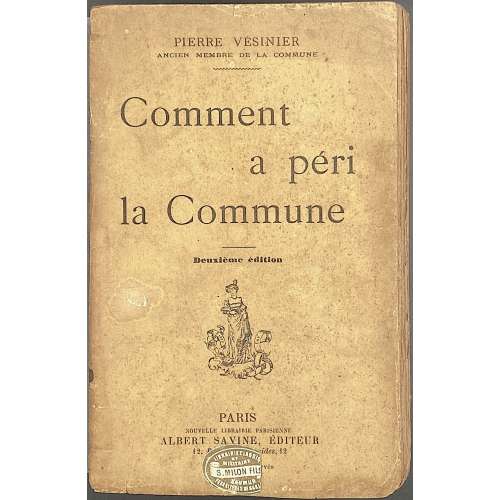 Softcover, 19 x 12 cm, publisher’s yellow wrappers with lettering to front, rear and spine, pp. [i-v] vi-xix [xx] [1] 2-474 [6], including index pp. 465-71 and contents pp.473-74. Bookseller’s label to front wrapper in the bottom: « LIBRAIRIE CLASSIQUE | ET | MILITAIRE | S. MILON FILS | SAUMUR | FOURNITURES DE BUREAU » Title-page: Pierre Vésinier | ANCIEN MEMBRE DE LA COMMUNE | — | COMMENT A PÉRI | LA COMMUNE | {publisher’s device} | PARIS | NOUVELLE LIBRAIRIE PARISIENNE | ALBERT SAVINE, ÉDITEUR | 12, RUE DES PYRAMIDES, 12 | – | Tous droits réservés. || Contributors: Pierre Vésinier (French, 1824 – 1902) – author. Albert Savine (French, 1859 – 1927) – publisher. Imprimerie de Saint-Denis, H. Bouillant (Paris) – printer.
Softcover, 19 x 12 cm, publisher’s yellow wrappers with lettering to front, rear and spine, pp. [i-v] vi-xix [xx] [1] 2-474 [6], including index pp. 465-71 and contents pp.473-74. Bookseller’s label to front wrapper in the bottom: « LIBRAIRIE CLASSIQUE | ET | MILITAIRE | S. MILON FILS | SAUMUR | FOURNITURES DE BUREAU » Title-page: Pierre Vésinier | ANCIEN MEMBRE DE LA COMMUNE | — | COMMENT A PÉRI | LA COMMUNE | {publisher’s device} | PARIS | NOUVELLE LIBRAIRIE PARISIENNE | ALBERT SAVINE, ÉDITEUR | 12, RUE DES PYRAMIDES, 12 | – | Tous droits réservés. || Contributors: Pierre Vésinier (French, 1824 – 1902) – author. Albert Savine (French, 1859 – 1927) – publisher. Imprimerie de Saint-Denis, H. Bouillant (Paris) – printer. -
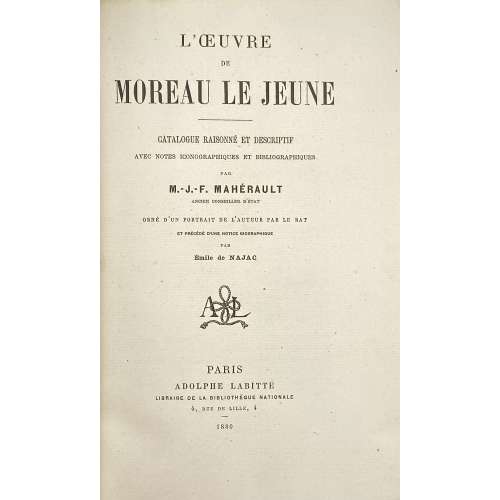 Binding: Hardcover, 25.5 x 17.8 x 4.7 cm, collated 4to, ¾ brown crushed morocco, bordered with gilt double fillet, raised bands, gilt fleurons in compartments, gelt lettering, marbled endpapers, top margin gilt; text printed on laid paper; frontis. on wove paper. Title-page: L'OEUVRE | DE | MOREAU LE JEUNE | — | CATALOGUE RAISONNÉ ET DESCRIPTIF | AVEC NOTES ICONOGRAPHIQUES ET BIBLIOGRAPHIQUES | PAR | M.- J.- F. MAHÉRAULT | ANCIEN CONSEILLER D’ÉTAT | ORNÉ D’UN PORTRAIT DE L’AUTEUR PAR LE RAT | ET PRÉCÉDÉ D’UNE NOTICE BIOGRAPHIQUE | PAR | Émile de Najac | {publisher’s device} | PARIS | ADOLPHE LABITTE | LIBRAIRE DE LA BIBLIOTHÈQUE NATIONALE | 4, RUE DE LILLE, 4 | – | 1880 || Collation: ffl, π2 (h.t., t.p.), a4 b2 1-674 682, 4ffl; total 278 leaves within flyleaves plus engraved frontispiece portrait of M.-J.-F. Mahérault by Paul Edme Le Rat w/tissue guard. Pagination: [4] [i] ii-xi [xii blank], [1] 2-538 (with page 538 erroneously numbered 568) [2 colophon/blank]; total 556 pages, ils. Contributors: Jean Michel Moreau [Moreau le Jeune] (French, 1741 – 1814) – artist, character. Marie Joseph François Mahérault (French, (1795 – 1879) – author, text. Comte Émile de Najac (French, 1828 – 1889) – author, biography. Paul-Edme Le Rat (French, 1849 – 1892) – artist, engraver. Adolphe Labitte (French, 1832 – 1882) – publisher. Georges Chamerot (French, 1845 – 1922) – printer.
Binding: Hardcover, 25.5 x 17.8 x 4.7 cm, collated 4to, ¾ brown crushed morocco, bordered with gilt double fillet, raised bands, gilt fleurons in compartments, gelt lettering, marbled endpapers, top margin gilt; text printed on laid paper; frontis. on wove paper. Title-page: L'OEUVRE | DE | MOREAU LE JEUNE | — | CATALOGUE RAISONNÉ ET DESCRIPTIF | AVEC NOTES ICONOGRAPHIQUES ET BIBLIOGRAPHIQUES | PAR | M.- J.- F. MAHÉRAULT | ANCIEN CONSEILLER D’ÉTAT | ORNÉ D’UN PORTRAIT DE L’AUTEUR PAR LE RAT | ET PRÉCÉDÉ D’UNE NOTICE BIOGRAPHIQUE | PAR | Émile de Najac | {publisher’s device} | PARIS | ADOLPHE LABITTE | LIBRAIRE DE LA BIBLIOTHÈQUE NATIONALE | 4, RUE DE LILLE, 4 | – | 1880 || Collation: ffl, π2 (h.t., t.p.), a4 b2 1-674 682, 4ffl; total 278 leaves within flyleaves plus engraved frontispiece portrait of M.-J.-F. Mahérault by Paul Edme Le Rat w/tissue guard. Pagination: [4] [i] ii-xi [xii blank], [1] 2-538 (with page 538 erroneously numbered 568) [2 colophon/blank]; total 556 pages, ils. Contributors: Jean Michel Moreau [Moreau le Jeune] (French, 1741 – 1814) – artist, character. Marie Joseph François Mahérault (French, (1795 – 1879) – author, text. Comte Émile de Najac (French, 1828 – 1889) – author, biography. Paul-Edme Le Rat (French, 1849 – 1892) – artist, engraver. Adolphe Labitte (French, 1832 – 1882) – publisher. Georges Chamerot (French, 1845 – 1922) – printer. -
 Hand-coloured woodcut on wove paper, 400 x 270 mm; black ink stamp “5306” to reverse. Top centre: "FAMILLE IMPÉRIALE", right: "62."; below centre: "Fabrique d'Images de GANGEL et P. DIDION, à Metz."; right: "Déposé." Publisher/printer: Gangel et P. Didion (Metz); Paulin Didion (French, 1831 – 1879). Characters: Napoleon III [Charles-Louis Napoléon Bonaparte] (French, 1808 – 1873) Eugénie de Montijo [L'impératrice Eugénie] (Spanish-French, 1826 – 1920) Napoléon, Prince Imperial (Napoléon Eugène Louis Jean Joseph Bonaparte] (French, 1856 – 1879) Napoléon II [Napoléon François Joseph Charles Bonaparte] (French, 1811 – 1832) Napoléon Ier [Napoléon Bonaparte] (French, 1769 – 1821)
Hand-coloured woodcut on wove paper, 400 x 270 mm; black ink stamp “5306” to reverse. Top centre: "FAMILLE IMPÉRIALE", right: "62."; below centre: "Fabrique d'Images de GANGEL et P. DIDION, à Metz."; right: "Déposé." Publisher/printer: Gangel et P. Didion (Metz); Paulin Didion (French, 1831 – 1879). Characters: Napoleon III [Charles-Louis Napoléon Bonaparte] (French, 1808 – 1873) Eugénie de Montijo [L'impératrice Eugénie] (Spanish-French, 1826 – 1920) Napoléon, Prince Imperial (Napoléon Eugène Louis Jean Joseph Bonaparte] (French, 1856 – 1879) Napoléon II [Napoléon François Joseph Charles Bonaparte] (French, 1811 – 1832) Napoléon Ier [Napoléon Bonaparte] (French, 1769 – 1821) -
 Fuchi-kashira of copper, carved and inlaid with gold and shakudō, with the design of Kanzan (on kashira), Chinese: Hanshan, an eccentric poet of the Tang dynasty with a scroll (618-906) who befriended Jittoku (on fuchi, Chinese: Shide, a kitchen helper at a mountain temple, holding a broom). Fuchi is signed Josui (如⽔). Fuchi (Jittoku, holding a broom): 38 x 22 x 12 mm. Weight: 23g (Nakago hole: 27 x 8.5 mm); Kashira (Kanzan, reading a scroll): 34 x 17 x 9 mm. Weight: 10g. Materials: Copper, gold, shakudō. Techniques: Tsuchi-me-ji (hammer-marked surface); usu-shishiai-bori or usuniku-bori (low-relief carving which leaves the image somewhat higher than the surface - high relief effect); zōgan (inlay). Josui was a daughter of Jochiku Kamo (Markus Sesko, Genealogies).
Fuchi-kashira of copper, carved and inlaid with gold and shakudō, with the design of Kanzan (on kashira), Chinese: Hanshan, an eccentric poet of the Tang dynasty with a scroll (618-906) who befriended Jittoku (on fuchi, Chinese: Shide, a kitchen helper at a mountain temple, holding a broom). Fuchi is signed Josui (如⽔). Fuchi (Jittoku, holding a broom): 38 x 22 x 12 mm. Weight: 23g (Nakago hole: 27 x 8.5 mm); Kashira (Kanzan, reading a scroll): 34 x 17 x 9 mm. Weight: 10g. Materials: Copper, gold, shakudō. Techniques: Tsuchi-me-ji (hammer-marked surface); usu-shishiai-bori or usuniku-bori (low-relief carving which leaves the image somewhat higher than the surface - high relief effect); zōgan (inlay). Josui was a daughter of Jochiku Kamo (Markus Sesko, Genealogies). -
 Mokkō form iron tsuba carved in relief and inlaid with soft metals (copper, gold, silver) with the design of a cormorant fisherman on the face and a boat on the reverse. Unsigned. Dimensions: 77 mm x 69 mm x 3.0 mm (at seppa-dai) Edo period: 18th or 19th century. "Since Nara period, Japanese fishermen in small boats have used cormorants (u) to catch river fish at night, binding the necks of the birds so that the fish are not swallowed. [...] The bird and the work it performs are symbols of selfless devotion to one's master and keen eyesight." - from Merrily Baird. Symbols of Japan. Thematic motifs in art and design. Rizzoli international publications, Inc., 2001; p. 104. See also in this collection TSU-0212 and TSU-0241.
Mokkō form iron tsuba carved in relief and inlaid with soft metals (copper, gold, silver) with the design of a cormorant fisherman on the face and a boat on the reverse. Unsigned. Dimensions: 77 mm x 69 mm x 3.0 mm (at seppa-dai) Edo period: 18th or 19th century. "Since Nara period, Japanese fishermen in small boats have used cormorants (u) to catch river fish at night, binding the necks of the birds so that the fish are not swallowed. [...] The bird and the work it performs are symbols of selfless devotion to one's master and keen eyesight." - from Merrily Baird. Symbols of Japan. Thematic motifs in art and design. Rizzoli international publications, Inc., 2001; p. 104. See also in this collection TSU-0212 and TSU-0241. -
 Le Petit Chaperon rouge (Little Red Riding Hood), three wood engravings by Gustave Doré, 1864: "En passant dans un bois elle rencontra compère le Loup"; "Le Chaperon rouge fut bien étonné de voir comment sa grand'mère était faite en son déshabillé"; "Cela n'empêche pas qu'avec ses gran dents il avait mangé une bonne grand'mère". Engraved by Adolphe Pannemaker. Le Petit Poucet (Little Thumb), one wood engraving by Gustave Doré, 1864: "Une bonne femme vint leur ouvrir". Engraved by Héliodore-Joseph Pisan. La Belle au bois dormant (Sleeping Beauty), one wood engraving by Gustave Doré, 1864: "Il marcha vers le château qu'il voyait au bout d'une grande avenue où il entra". Engraved by Héliodore-Joseph Pisan. Medium: Paper; Wood engraving. Illustrations for P.-J. Hetzel's edition of Perrault's Fairy Tales (Les Contes de Perrault) by Gustave Doré published in 1864. Size: frame: 428 x 302 mm; sheet: 280 x 231 mm; image: 194 x 244 mm.
Le Petit Chaperon rouge (Little Red Riding Hood), three wood engravings by Gustave Doré, 1864: "En passant dans un bois elle rencontra compère le Loup"; "Le Chaperon rouge fut bien étonné de voir comment sa grand'mère était faite en son déshabillé"; "Cela n'empêche pas qu'avec ses gran dents il avait mangé une bonne grand'mère". Engraved by Adolphe Pannemaker. Le Petit Poucet (Little Thumb), one wood engraving by Gustave Doré, 1864: "Une bonne femme vint leur ouvrir". Engraved by Héliodore-Joseph Pisan. La Belle au bois dormant (Sleeping Beauty), one wood engraving by Gustave Doré, 1864: "Il marcha vers le château qu'il voyait au bout d'une grande avenue où il entra". Engraved by Héliodore-Joseph Pisan. Medium: Paper; Wood engraving. Illustrations for P.-J. Hetzel's edition of Perrault's Fairy Tales (Les Contes de Perrault) by Gustave Doré published in 1864. Size: frame: 428 x 302 mm; sheet: 280 x 231 mm; image: 194 x 244 mm. -
 Artist: Utagawa Kunisada, a.k.a. Toyokuni III (Japanese, 1786 – 1865) [歌川 国貞]. Publisher: Ibaya Senzaburō [伊場屋仙三郎] (Japanese, fl. C. 1845 – 1847). Date aratame seal: Bunsei 12 (1829). Signed: Gototei Kunisada ga [五渡亭国貞画]. Media: Fan print (uchiwa-e), 272 x 235 mm. Actor: Iwai Hanshirō VI (Japanese, 1799 – 1836); other names: Iwai Hanshirō VI, Iwai Kumesaburō II, Iwai Hisajirō I, Baiga [梅我] (poetry name), Shūka (poetry name). The background is Arare-ko-mon [霰小紋] hail pattern. Kabuki actor Iwai Kumesaburō II in the role of An no Heibei [安の平兵衛] in the drama Otokodate Itsutsu Karigane [男作五雁金] (Play, 7 acts. Produced 1742/09). From Lyon collection: The real An no Heibei (ca. 1672-1702): "In a gang with Kaitate no Kichiemon, Hote no Ichiemon, Mippiki Jihei and others as of the Seventh Month of 1697. Attacked people with a sword on the sixth day, Seventh Month, 1699, which he then secreted with Kichiemon. On the evening of the sixth day, Sixth Month, 1701, stabbed Kibei, an employee of Kawachiya Gohei of the residential quarter Kyuhoji, in the side with a dagger. A subsequent police investigation resulted in Heibei's arrest the following day. Beheaded at the execution grounds located at Sennichi Mae on the twenty-sixth day of the Eighth Month, 1702." Note: According to Horst Graebner, the actor's name below the series title in the cartouche is Baiga (梅我), the poetry name of Iwai Kumesaburō II. On the other prints in this series, the actors are also named on the other prints with their poetry names. In the red cartouche at the top left is the series title "Edo no hana – itsutsu Karigane" (江戸の花 五雁金), to be translated as "Flowers of Edo - the five Karigane blood-brothers" (or "the five Karigane gang members"). "Since there was no performance with the Karigane brothers from 1829, these must be mitate prints", states Mr Graebner.
Artist: Utagawa Kunisada, a.k.a. Toyokuni III (Japanese, 1786 – 1865) [歌川 国貞]. Publisher: Ibaya Senzaburō [伊場屋仙三郎] (Japanese, fl. C. 1845 – 1847). Date aratame seal: Bunsei 12 (1829). Signed: Gototei Kunisada ga [五渡亭国貞画]. Media: Fan print (uchiwa-e), 272 x 235 mm. Actor: Iwai Hanshirō VI (Japanese, 1799 – 1836); other names: Iwai Hanshirō VI, Iwai Kumesaburō II, Iwai Hisajirō I, Baiga [梅我] (poetry name), Shūka (poetry name). The background is Arare-ko-mon [霰小紋] hail pattern. Kabuki actor Iwai Kumesaburō II in the role of An no Heibei [安の平兵衛] in the drama Otokodate Itsutsu Karigane [男作五雁金] (Play, 7 acts. Produced 1742/09). From Lyon collection: The real An no Heibei (ca. 1672-1702): "In a gang with Kaitate no Kichiemon, Hote no Ichiemon, Mippiki Jihei and others as of the Seventh Month of 1697. Attacked people with a sword on the sixth day, Seventh Month, 1699, which he then secreted with Kichiemon. On the evening of the sixth day, Sixth Month, 1701, stabbed Kibei, an employee of Kawachiya Gohei of the residential quarter Kyuhoji, in the side with a dagger. A subsequent police investigation resulted in Heibei's arrest the following day. Beheaded at the execution grounds located at Sennichi Mae on the twenty-sixth day of the Eighth Month, 1702." Note: According to Horst Graebner, the actor's name below the series title in the cartouche is Baiga (梅我), the poetry name of Iwai Kumesaburō II. On the other prints in this series, the actors are also named on the other prints with their poetry names. In the red cartouche at the top left is the series title "Edo no hana – itsutsu Karigane" (江戸の花 五雁金), to be translated as "Flowers of Edo - the five Karigane blood-brothers" (or "the five Karigane gang members"). "Since there was no performance with the Karigane brothers from 1829, these must be mitate prints", states Mr Graebner. -
![Le Comte de Arthur Grandeffe. Paris sous Napoléon III. Mémoires d'un homme du monde de 1857 à 1870 / Par Le Comte de Arthur Grandeffe. — Paris: Imp. et Lib. Centrales des Chemins de Fer, A. Chaix et Cie., 1870. — pp.: ff [2 ht, blank] [2 title, blank] [i] i-vi, 1-413 [1] bf.](https://varshavskycollection.com/wp-content/uploads/2021/02/LIB-2449.2020-a-1-500x500.jpeg) Front wrapper: PARIS SOUS NAPOLÉON III | Mémoires d'un homme du monde | DE 1857 À 1870 | PAR LE COMTE DE ARTHUR GRANDEFFE | {publisher’s device} | PARIS: IMPRIMERIE ET LIBRAIRIE CENTRALES DES CHEMINS DE FER | A. CHAIX ET Cie | RUE BERGÈRE 20, PRÈS DU BOULEVARD MONTMARTRE | 1879 || Similar lettering to t.p. Softcover 18.5 x 12 cm, publisher’s original blue wrappers, first and last leaves glued to wrappers, unevenly trimmed, some uncut, pagination [4] [i] ii-vi, [1] 2-413 [414], authors advert to back wrapper; mispaginated pp. 136-141; collation: 18mo, π6, 1-2218 236. Sticker with gilt lettering to front wrapper “LIBRAIRIE CENTRALE | BERTRAND & QUEYROT | MENTON”; sticker to spine "577".
Front wrapper: PARIS SOUS NAPOLÉON III | Mémoires d'un homme du monde | DE 1857 À 1870 | PAR LE COMTE DE ARTHUR GRANDEFFE | {publisher’s device} | PARIS: IMPRIMERIE ET LIBRAIRIE CENTRALES DES CHEMINS DE FER | A. CHAIX ET Cie | RUE BERGÈRE 20, PRÈS DU BOULEVARD MONTMARTRE | 1879 || Similar lettering to t.p. Softcover 18.5 x 12 cm, publisher’s original blue wrappers, first and last leaves glued to wrappers, unevenly trimmed, some uncut, pagination [4] [i] ii-vi, [1] 2-413 [414], authors advert to back wrapper; mispaginated pp. 136-141; collation: 18mo, π6, 1-2218 236. Sticker with gilt lettering to front wrapper “LIBRAIRIE CENTRALE | BERTRAND & QUEYROT | MENTON”; sticker to spine "577". -
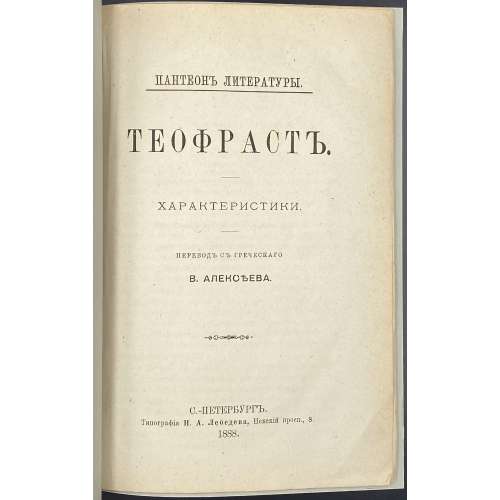 Title page: ПАНТЕОНЪ ЛИТЕРАТУРЫ | ТЕОФРАСТЪ. | ХАРАКТЕРИСТИКИ. | ПЕРЕВОДЪ СЪ ГРЕЧЕСКАГО | В. АЛЕКСѢЕВА. |—| С.–ПЕТЕРБУРГЪ. | Типографiя Н. А. Лебедева, Невскiй просп., 8. | 1888. || Pagination: [1-3] 4-32; 32 pages. Collation: 8vo; 1-28; 16 leaves. Binding: Modern owner’s grey wrappers, blank. Page size: 23.2 x 16 cm Contributors: Theophrastus [Θεόφραστος, Theόphrastos, Теофраст, Феофраст] (Greek, c. 371 – c. 287 BC) – author. Алексеев, Василий Алексеевич (Russian, 1863 – 1919) – translator. Лебедев, Николай Афанасьевич (Russian, 1813 – 1896); Типография Н. А. Лебедева (СПб) – publisher, printer.
Title page: ПАНТЕОНЪ ЛИТЕРАТУРЫ | ТЕОФРАСТЪ. | ХАРАКТЕРИСТИКИ. | ПЕРЕВОДЪ СЪ ГРЕЧЕСКАГО | В. АЛЕКСѢЕВА. |—| С.–ПЕТЕРБУРГЪ. | Типографiя Н. А. Лебедева, Невскiй просп., 8. | 1888. || Pagination: [1-3] 4-32; 32 pages. Collation: 8vo; 1-28; 16 leaves. Binding: Modern owner’s grey wrappers, blank. Page size: 23.2 x 16 cm Contributors: Theophrastus [Θεόφραστος, Theόphrastos, Теофраст, Феофраст] (Greek, c. 371 – c. 287 BC) – author. Алексеев, Василий Алексеевич (Russian, 1863 – 1919) – translator. Лебедев, Николай Афанасьевич (Russian, 1813 – 1896); Типография Н. А. Лебедева (СПб) – publisher, printer. -
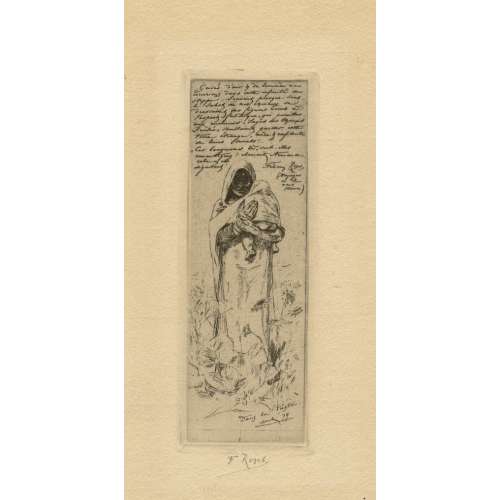
Etching and drypoint, signed in pencil by the artist under the plate; 2nd state. Pasted on a sheet of blue paper. Fragment of "La messe de Gnide". Owner's stamp 'LvM' on verso.
Dimensions: Blue paper: 32 x 27 cm; Laid paper: 30.7 x 22 cm; Image: 12.5 x 4 cm.
Catalogue raisonné: Arthur Hubschmid (1977): 364; Graphics irreverent and erotic (1968): 59; Rouir: 508.
-
 An uncut fan print showing a young woman checking her makeup in a mirror from the series The pride of Edo [江戸じまん] (Edo jiman). The head portrait in the red circle is of kabuki actor Danjūrō VII. Ichikawa Danjūrō VII [市川団十郎] (Japanese, 1791 – 1859); other names: Ichikawa Ebizō V, Ichikawa Hakuen II, Ichikawa Shinnosuke I. Artist: Utagawa Kunisada [歌川 国貞] a.k.a. Utagawa Toyokuni III [三代 歌川 豊国] (Japanese, 1786 – 1865). Publisher: Ibaya Kyūbei [伊場屋 久兵衛] (Japanese, fl. 1804 – 1851). Artists signature: Ōkō Kunisada ga [應好国貞画] (Drawn to satisfy the taste of Kunisada) Publisher’s seal:久 – Ibakyū [伊場久]. Censor's seal: Kiwame; date seal: Bunsei 10 (1827). Saze: Aiban uchiwa-e; 23.2 x 28.9 cm. Ref.: [LIB-2967.2022] Utagawa Kunisada (1786 – 1865): His world revisited / Catalogue № 17, Exhibition March 17-21, 2021. — NY: Sebastian Izzard, LLC., 2021; p. 102, Cat. 28–fig. a.
An uncut fan print showing a young woman checking her makeup in a mirror from the series The pride of Edo [江戸じまん] (Edo jiman). The head portrait in the red circle is of kabuki actor Danjūrō VII. Ichikawa Danjūrō VII [市川団十郎] (Japanese, 1791 – 1859); other names: Ichikawa Ebizō V, Ichikawa Hakuen II, Ichikawa Shinnosuke I. Artist: Utagawa Kunisada [歌川 国貞] a.k.a. Utagawa Toyokuni III [三代 歌川 豊国] (Japanese, 1786 – 1865). Publisher: Ibaya Kyūbei [伊場屋 久兵衛] (Japanese, fl. 1804 – 1851). Artists signature: Ōkō Kunisada ga [應好国貞画] (Drawn to satisfy the taste of Kunisada) Publisher’s seal:久 – Ibakyū [伊場久]. Censor's seal: Kiwame; date seal: Bunsei 10 (1827). Saze: Aiban uchiwa-e; 23.2 x 28.9 cm. Ref.: [LIB-2967.2022] Utagawa Kunisada (1786 – 1865): His world revisited / Catalogue № 17, Exhibition March 17-21, 2021. — NY: Sebastian Izzard, LLC., 2021; p. 102, Cat. 28–fig. a. -
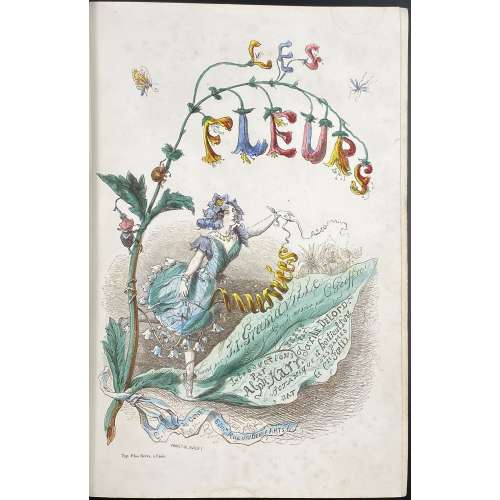 Description: Two parts in one volume, collated 4to, 26.3 x 18 cm, bound in quarter green pebbled morocco over green percaline panelled boards, spine with raised bands, gilt in compartments, lettered in gilt, signed in the bottom “L. Curmer”; marbled endpapers, all edges gilt. Part 1 is illustrated with a hand-coloured wood-engraved title-page by Porret and Blanadet and 28 hand-coloured steel engravings by Charles Geoffroy after J.-J. Grandville; part 2 is illustrated with a hand-coloured wood-engraved title-page by Quichon and 22 steel engravings by Charles Geoffroy after J.-J. Grandville, and two uncoloured botanical plates, unsigned. Title-page: LES | FLEURS ANIMÉES | PAR | J.-J. GRANDVILLE | INTRODUCTIONS | Par ALPH. KARR | TEXTE | Par TAXILE DELORD | — | PREMIÈRE (DEUXIÈME) PARTIE | — | PARIS | GABRIEL DE GONET, ÉDITEUR | 6, RUE DES BEAUX-ARTS, 6 || Collation: part 1: blank, [1] h.t./imprint (PARIS WALDER), hand-coloured engraved t.p., [1] t.p./blank, 1-324, [1] contents/blank, 28 hand-coloured plates; part 2: [1] h.t./imprint (PARIS WALDER), hand-coloured engraved t.p., [1] t.p./blank, [2] intro., [1]-294, 302, blank, 22 hand-coloured plates and 2 uncoloured plates. Pagination: part 1: [1-5] 6-260 [2] (total 262 pages), ils; part 2: [4] [i] ii-iv [1] 2-102, [2] [i] ii-iv, [105] 106-234 [2] (total 248 pages), ils. Coloured steel-engraved plates: Part 1: Bleuet et Coquelicot. Lis. Pensée. Tabac. Tulipe. Rose. Narcisse. Violette. Nenuphar. Laurier. Myrte. Marguerite. Camelia. Immortelle. Chèvre-feuille. Belle-de-nuit. Oeillet. Ciguë. Soleil. Fleur de grenadier. Lin. Eglantine. Pavot. Chardon. Fleur d'oranger. Capucine. Guimauve. Primevère – Perce-neige. Part 2: Pois de senteur. Cactus. Dahlia. Sensitive. Fleur de pêcher. Aubépine. Vigne. Myosotis. Jasmin. Scabieuse & Souci. Traite des fleurs. Flèche-d'eau. Hortensia, couronne impériale. Verveine. Giroflée. Thé et Café. Lilas. Tubéreuse Jonquille. Bal. Retour des fleurs. Erratum. Pervenche desséchée. Plates signed "Grandville del. – Ch. Geoffroy sc. – G. de Gonet, editeur" but some signed "Imp. Delamain et Sarazin rue Git le Cœur 8 Paris." Plates accompanied by tissue guards. Gordon N. Ray: "Most of the plates show an elegant lady in a garden, her dress covered with an extraordinary pattern of flowers. She is sometimes accompanied by respectful creatures, animals and insects, even fish and reptiles". Edition: 2nd edition of 1847, each part has separate pagination; imprint: "Paris. — Typographie Walder, rue Bonaparte, 44". Second "tirage", the volumes being paged separately; the first "tirage", issued also in 1847, is paged continuously. Point of issue: Table des Matières has "Imprimerte Walder." Originally appeared in 83 separate parts in pictorial yellow wrappers. Contributors: J.-J. Grandville [Gèrard, Isidore-Adolphe] (French, 1803 – 1847) – artist. Taxile Delord (French, 1815 – 1877) – author. Comte Foelix [Louis-François Raban] (French, 1795 – 1870) – author. Jean-Baptiste Alphonse Karr (French, 1808 – 1890) – author. Charles Michel Geoffroy (French, 1819 – 1882) – engraver (on steel). Gabriel de Gonet (French, fl. 1847 – 1862) – publisher. Typographie Walder (Paris) – printer. Plon Freres (Paris) – printer. Delamain et Sarrazin (Paris) – printer. Henri Désiré Porret (French, 1800 – 1867) – engraver (on wood). Jules Blanadet (French, 1824 – ?) – engraver (on wood). Quichon (French, fl. c. 1850s) – engraver (on wood). Catalogue raisonné: L. Carteret (Le trésor): p. 286; Ray (French): 198, pp. 278-9; Vicaire (Manuel): D III, p. 133-4; Brivois (Guide): pp. 147-150. In collections: MET 1970.565.423.1–.2; Vanderbilt University; V&A L.755-1943. Provenance: Léon Curmer (French, ).
Description: Two parts in one volume, collated 4to, 26.3 x 18 cm, bound in quarter green pebbled morocco over green percaline panelled boards, spine with raised bands, gilt in compartments, lettered in gilt, signed in the bottom “L. Curmer”; marbled endpapers, all edges gilt. Part 1 is illustrated with a hand-coloured wood-engraved title-page by Porret and Blanadet and 28 hand-coloured steel engravings by Charles Geoffroy after J.-J. Grandville; part 2 is illustrated with a hand-coloured wood-engraved title-page by Quichon and 22 steel engravings by Charles Geoffroy after J.-J. Grandville, and two uncoloured botanical plates, unsigned. Title-page: LES | FLEURS ANIMÉES | PAR | J.-J. GRANDVILLE | INTRODUCTIONS | Par ALPH. KARR | TEXTE | Par TAXILE DELORD | — | PREMIÈRE (DEUXIÈME) PARTIE | — | PARIS | GABRIEL DE GONET, ÉDITEUR | 6, RUE DES BEAUX-ARTS, 6 || Collation: part 1: blank, [1] h.t./imprint (PARIS WALDER), hand-coloured engraved t.p., [1] t.p./blank, 1-324, [1] contents/blank, 28 hand-coloured plates; part 2: [1] h.t./imprint (PARIS WALDER), hand-coloured engraved t.p., [1] t.p./blank, [2] intro., [1]-294, 302, blank, 22 hand-coloured plates and 2 uncoloured plates. Pagination: part 1: [1-5] 6-260 [2] (total 262 pages), ils; part 2: [4] [i] ii-iv [1] 2-102, [2] [i] ii-iv, [105] 106-234 [2] (total 248 pages), ils. Coloured steel-engraved plates: Part 1: Bleuet et Coquelicot. Lis. Pensée. Tabac. Tulipe. Rose. Narcisse. Violette. Nenuphar. Laurier. Myrte. Marguerite. Camelia. Immortelle. Chèvre-feuille. Belle-de-nuit. Oeillet. Ciguë. Soleil. Fleur de grenadier. Lin. Eglantine. Pavot. Chardon. Fleur d'oranger. Capucine. Guimauve. Primevère – Perce-neige. Part 2: Pois de senteur. Cactus. Dahlia. Sensitive. Fleur de pêcher. Aubépine. Vigne. Myosotis. Jasmin. Scabieuse & Souci. Traite des fleurs. Flèche-d'eau. Hortensia, couronne impériale. Verveine. Giroflée. Thé et Café. Lilas. Tubéreuse Jonquille. Bal. Retour des fleurs. Erratum. Pervenche desséchée. Plates signed "Grandville del. – Ch. Geoffroy sc. – G. de Gonet, editeur" but some signed "Imp. Delamain et Sarazin rue Git le Cœur 8 Paris." Plates accompanied by tissue guards. Gordon N. Ray: "Most of the plates show an elegant lady in a garden, her dress covered with an extraordinary pattern of flowers. She is sometimes accompanied by respectful creatures, animals and insects, even fish and reptiles". Edition: 2nd edition of 1847, each part has separate pagination; imprint: "Paris. — Typographie Walder, rue Bonaparte, 44". Second "tirage", the volumes being paged separately; the first "tirage", issued also in 1847, is paged continuously. Point of issue: Table des Matières has "Imprimerte Walder." Originally appeared in 83 separate parts in pictorial yellow wrappers. Contributors: J.-J. Grandville [Gèrard, Isidore-Adolphe] (French, 1803 – 1847) – artist. Taxile Delord (French, 1815 – 1877) – author. Comte Foelix [Louis-François Raban] (French, 1795 – 1870) – author. Jean-Baptiste Alphonse Karr (French, 1808 – 1890) – author. Charles Michel Geoffroy (French, 1819 – 1882) – engraver (on steel). Gabriel de Gonet (French, fl. 1847 – 1862) – publisher. Typographie Walder (Paris) – printer. Plon Freres (Paris) – printer. Delamain et Sarrazin (Paris) – printer. Henri Désiré Porret (French, 1800 – 1867) – engraver (on wood). Jules Blanadet (French, 1824 – ?) – engraver (on wood). Quichon (French, fl. c. 1850s) – engraver (on wood). Catalogue raisonné: L. Carteret (Le trésor): p. 286; Ray (French): 198, pp. 278-9; Vicaire (Manuel): D III, p. 133-4; Brivois (Guide): pp. 147-150. In collections: MET 1970.565.423.1–.2; Vanderbilt University; V&A L.755-1943. Provenance: Léon Curmer (French, ). -
 Artist: Utagawa Kunisada [歌川 国貞] a.k.a. Utagawa Toyokuni III [三代歌川豊国] (Japanese, 1786 – 1865). Pubisher (accorfding to Suzuki & Oka): Ibaya Senzaburō [伊場屋仙三郎] (Japanese, 1815 – 1869), Dansendō [伊場仙]. Title: Beauty holding a roll of paper (by seller); A woman of Edo (by Suzuki & Oka) Date seal and aratame censor seal: 1822 (Bunsei 5). Signed: Gototei Kunisada ga [五渡亭国貞画]. Media: Untrimmed fan print (uchiwa-e), 228 x 295 mm. Ref: [LIB-3085.2022] Jūzō Suzuki, Isaburō Oka. “The decadents”. — Tokyo: Kodansha International, 1969, p. 35, plate 30: exactly this print:
Artist: Utagawa Kunisada [歌川 国貞] a.k.a. Utagawa Toyokuni III [三代歌川豊国] (Japanese, 1786 – 1865). Pubisher (accorfding to Suzuki & Oka): Ibaya Senzaburō [伊場屋仙三郎] (Japanese, 1815 – 1869), Dansendō [伊場仙]. Title: Beauty holding a roll of paper (by seller); A woman of Edo (by Suzuki & Oka) Date seal and aratame censor seal: 1822 (Bunsei 5). Signed: Gototei Kunisada ga [五渡亭国貞画]. Media: Untrimmed fan print (uchiwa-e), 228 x 295 mm. Ref: [LIB-3085.2022] Jūzō Suzuki, Isaburō Oka. “The decadents”. — Tokyo: Kodansha International, 1969, p. 35, plate 30: exactly this print:
-
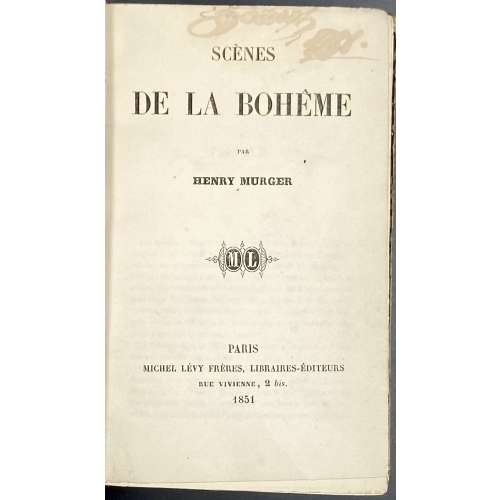 Hardcover volume, 18.2 x 11.8 cm, bound in quarter black polished calf with gilt lettering “cartonnage romantique” design to spine, marbled boards, matching marbled endpapers, blue margins. Title-page: SCÈNES | DE LA BOHÊME | PAR | HENRY MURGER | {publisher’s device ML} | PARIS | MICHEL LÉVY FRÈRES, LIBRAIRES-ÉDITEURS | RUE VIVIENNE, 2 bis. | 1851 || Half-title: ŒUVRES | D’HENRY MURGER || Advertisement: Chez le même Éditeurs. | BIBLIOTHEQUE CONTEMPORAINE | (page of text) || Collation: π2 (h.t/advert., t.p. / blank), 1-33 (17)12, χ6; total 212 leaves without ffls (3 front, 2 back). Pagination: [2] – h.t. / blank, [2] – t.p. / blank, [i] ii-xiii [xiv blank], [1] 2-406; total 424 pages. Scènes de la bohême, in later editions Scènes de la vie de bohème. Translations: Into English: LIB-2719.2021. Henri Murger. The Bohemians of the Latin Quarter. (Scènes de la vie de Bohême) / Translated from the French. — London: Vizetelly & Co., 1883. Into German: LIB-2686.2021. Henri Murger. Die Bohème : Szenen aus dem Pariser Künstlerleben. — Leipzig: Insel-Verlag, 1906. Into Russian: LIB-3182.2023. А. Мюрже. Сцены из жизни богемы / Пер. с франц. и прим. Е. А. Гунста; вст. ст. С. И. Великовского; художник Н. А. Кравченко. — М.: Художественная литература, 1963. Contributors: Murger, Henri [Henry] (French, 1822 – 1861) – author.
Hardcover volume, 18.2 x 11.8 cm, bound in quarter black polished calf with gilt lettering “cartonnage romantique” design to spine, marbled boards, matching marbled endpapers, blue margins. Title-page: SCÈNES | DE LA BOHÊME | PAR | HENRY MURGER | {publisher’s device ML} | PARIS | MICHEL LÉVY FRÈRES, LIBRAIRES-ÉDITEURS | RUE VIVIENNE, 2 bis. | 1851 || Half-title: ŒUVRES | D’HENRY MURGER || Advertisement: Chez le même Éditeurs. | BIBLIOTHEQUE CONTEMPORAINE | (page of text) || Collation: π2 (h.t/advert., t.p. / blank), 1-33 (17)12, χ6; total 212 leaves without ffls (3 front, 2 back). Pagination: [2] – h.t. / blank, [2] – t.p. / blank, [i] ii-xiii [xiv blank], [1] 2-406; total 424 pages. Scènes de la bohême, in later editions Scènes de la vie de bohème. Translations: Into English: LIB-2719.2021. Henri Murger. The Bohemians of the Latin Quarter. (Scènes de la vie de Bohême) / Translated from the French. — London: Vizetelly & Co., 1883. Into German: LIB-2686.2021. Henri Murger. Die Bohème : Szenen aus dem Pariser Künstlerleben. — Leipzig: Insel-Verlag, 1906. Into Russian: LIB-3182.2023. А. Мюрже. Сцены из жизни богемы / Пер. с франц. и прим. Е. А. Гунста; вст. ст. С. И. Великовского; художник Н. А. Кравченко. — М.: Художественная литература, 1963. Contributors: Murger, Henri [Henry] (French, 1822 – 1861) – author. -
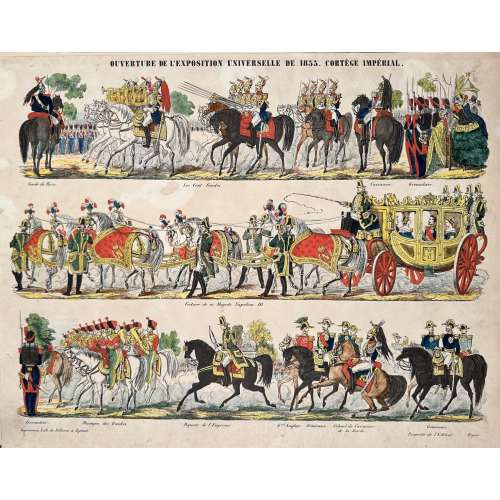 Hand-coloured woodcut on wove paper, 366 x 460 mm; black ink stamp “5057” to reverse. Caption cartoon in 2 tiers. Top: OUVERTURE DE 'EXPOSITION UNIVERSELLE DE 1855. CORTÈGE IMPÉRIAL. Captions top to bottom: Garde de Paris. — Les Cent Gardes. — Cuirassier. — Grenadiers. Middle: Voiture de sa Majesté Napoléon III. | Bottom: Grenadier. — Musique des Guides. — Piqueur de l’Empereur. — Gral Anglais — Généraux — Colonel de Cuirassiers | de la Garde — Généraux. Below left: Imprimerie Lith. de Pellerin, à Épinal; right: Propriété de l’Éditeur. Déposé. Jean Charles Pellerin (French, 1756 – 1836) – printer/publisher.
Hand-coloured woodcut on wove paper, 366 x 460 mm; black ink stamp “5057” to reverse. Caption cartoon in 2 tiers. Top: OUVERTURE DE 'EXPOSITION UNIVERSELLE DE 1855. CORTÈGE IMPÉRIAL. Captions top to bottom: Garde de Paris. — Les Cent Gardes. — Cuirassier. — Grenadiers. Middle: Voiture de sa Majesté Napoléon III. | Bottom: Grenadier. — Musique des Guides. — Piqueur de l’Empereur. — Gral Anglais — Généraux — Colonel de Cuirassiers | de la Garde — Généraux. Below left: Imprimerie Lith. de Pellerin, à Épinal; right: Propriété de l’Éditeur. Déposé. Jean Charles Pellerin (French, 1756 – 1836) – printer/publisher. -
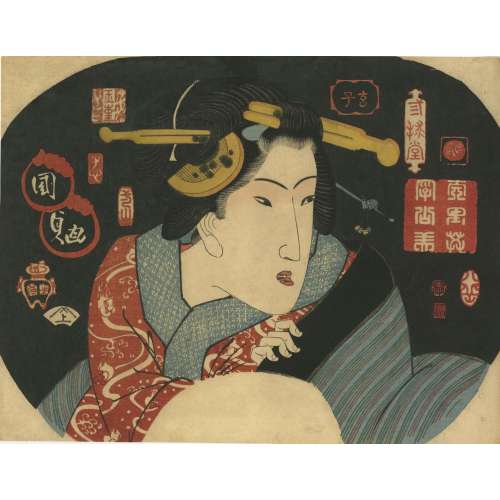 Artist: Utagawa Kunisada [歌川 国貞] a.k.a. Utagawa Toyokuni III [三代歌川豊国] (Japanese, 1786 – 1865). Publisher: Iseya Sōemon [伊勢屋惣右衛門] (Japanese, c. 1776 – 1862). Signed: Kunisada ga within a double toshidama. Date-kiwame seals: Bunsei 11 (1828).
Artist: Utagawa Kunisada [歌川 国貞] a.k.a. Utagawa Toyokuni III [三代歌川豊国] (Japanese, 1786 – 1865). Publisher: Iseya Sōemon [伊勢屋惣右衛門] (Japanese, c. 1776 – 1862). Signed: Kunisada ga within a double toshidama. Date-kiwame seals: Bunsei 11 (1828).


